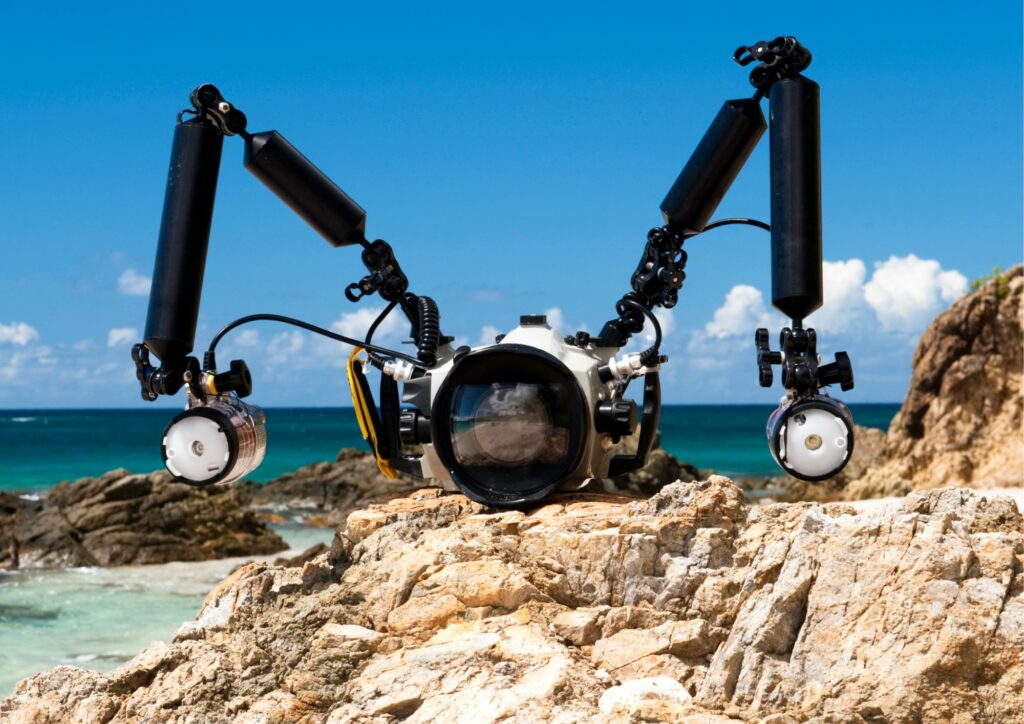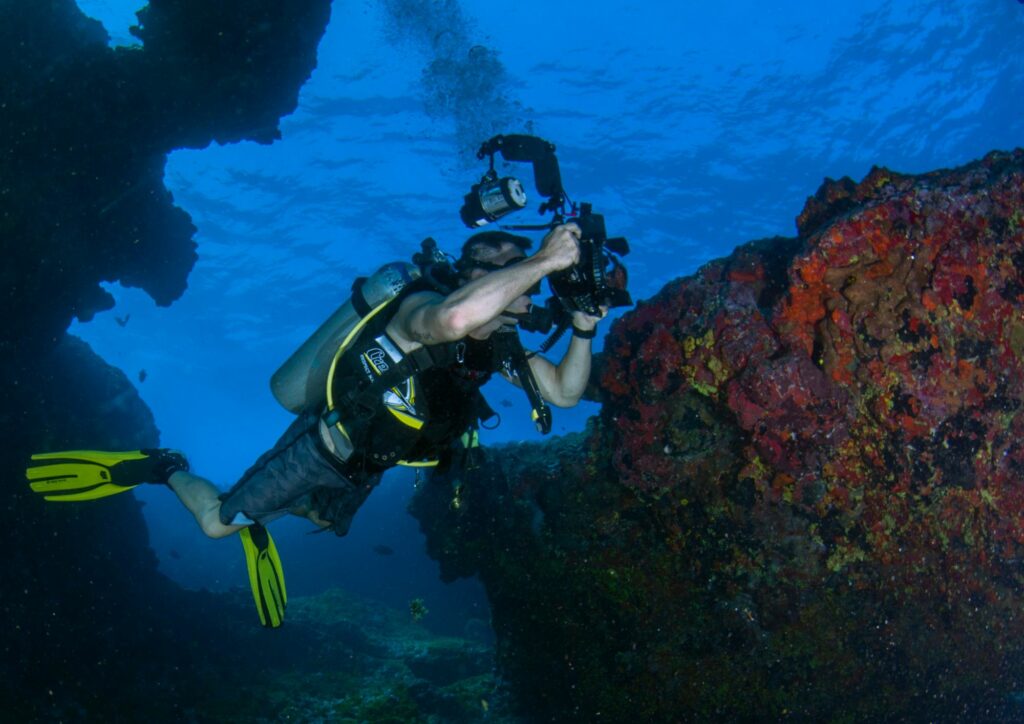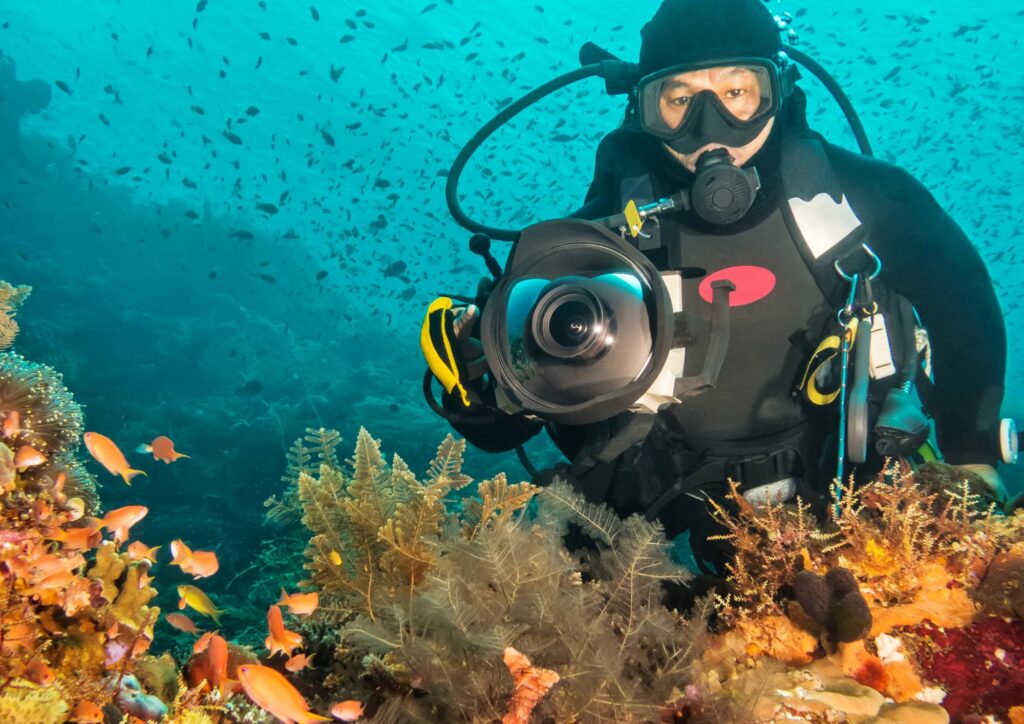This journey toward mastering underwater photography techniques isn’t always smooth sailing; it requires careful planning, tactful execution, and innate creativity. If you’re intrigued by the mysteries that lie beneath the ocean surface and yearn for capturing marine life in stunning detail, this blog post is for you. There is a profound wonder in the act of bringing to light the hidden marvels of the underwater world through the lens of your camera. But how exactly do you transfer the surreal beauty of the ocean’s depths into unforgettable photographs?
Get Geared Up: Choose the Right Dive Photography Equipment

The thrill of underwater photography begins not in the water, but on land, as you prepare yourself with essential gear. Considering the vast number of options available in the market, it can be quite overwhelming when it comes to choosing the right equipment. You can find everything from compact underwater cameras designed for the casual hobbyist, to sophisticated high-end DSLRs accompanied with waterproof casings catered to the professional photographer.
Choosing the perfect equipment largely depends on three primary factors: your level of photography skills, your budget, and the complexity of the shots you intend to capture. Desirable features in your equipment should include waterproofing and shock-resistance to handle the harsh underwater environment. Pay also attention to the resolution capabilities of your chosen device – high resolution ensures clear, sharp images that capture every detail. Lastly, consider the control settings for ease of use under the water, as managing equipment could be challenging when submerged.
Know Thy Subject: Research Before The Dive for Underwater Photography

In addition to mastering the technical aspects, gaining a deep understanding of your aquatic subjects greatly enhances your underwater photography art. Do comprehensive research about different marine species, observe their behaviors, habitats, and learn about the ideal times to spot them. This knowledge is vital as it shapes your dive sites and shooting schedule giving you the most optimal conditions for a great shoot. It’s important to distinguish between fast-moving aquatic creatures and those that remain stationary as this fundamentally influences your shooting techniques and camera settings. Being familiar with your subjects enables you to anticipate their movements, making it much easier to capture gorgeous, high-quality images.
Master Your Dive and Framing Techniques
Maneuvering fluidly in the water while handling your camera and going for that perfect shot needs great expertise. The possibility to capture a breath-taking image might only last a few fleeting seconds, making mobility and stability under water crucial. Enhance your buoyancy control and improve your lateral movements for optimal positioning in the water. The way you frame your subject can make a remarkable difference in your underwater photographs. Use features of the marine environment as natural frames – such as the fascinating sea bed, intricate coral formations, or sublime sun beams penetrating the sea surface – to breathe life into your shots and make them stand out.
Work the Light: Understand Underwater Lighting

Light behaves idiosyncratically underwater which directly impacts the appearance of your photos. Developing a profound understanding of how light behaves under water can substantially improve your photography skills. Shallow dives benefit greatly from natural light, with the sun’s rays lending a unique luminosity to your images. However, for deeper dives where natural light is scarce, artificial lighting becomes essential to bring out the vibrant colors of the underwater ecosystem. It’s crucial to avoid back-scattered light, as it might distort your beautiful underwater photos by creating an undesirable particle effect known as ‘backscatter’. Properly managing light underwater can make your images truly shine, reflecting the incredible beauty of subaqueous life.
Post-Dive: Photo Editing Techniques for Underwater Photography
Even the most striking underwater photographs can be improved upon through thoughtful post-processing. Being proficient in basic editing techniques such as adjusting levels, curves, saturation, and sharpening can further enhance the appeal of your captures. Such careful editing can rectify issues like underexposure, boost colors creating vibrancy, and bring out minute details that might’ve been overlooked, therefore, making your images more captivating. This final step of the process is just as vital in the world of underwater photography and plays a critical part in turning your captured moments into visual masterpieces.
The Last Splash: Concluding Dive
Mastering underwater photography is much more than just owning the finest gear. It’s about developing an understanding of marine behavior, gaining proficiency in scuba diving, utilizing light effectively and honing post-processing skills. But remember, no amount of expertise can replace passion and respect for the ocean. As you ignite your underwater photography journey with these dive photography tips, let your love for the ocean guide you and stay mindful to preserve its beauty for generations to come. Dive in, capture, conserve!

Love how this post breaks down the key elements of underwater photography. As a beginner, I found it really helpful to learn about the importance of research and mastering dive techniques. Can’t wait to put these tips into practice!
Hi Maya, we’re thrilled that our post helped you as a beginner! Research and mastering dive techniques are indeed crucial elements in underwater photography. Remember to also have fun and be patient with yourself as you practice. If you have any questions or need further guidance, feel free to reach out to us anytime. We’d love to help you improve your skills!
This post is a treasure trove of information! I’m blown away by the level of detail and expertise shared here. Can’t help but feel inspired to take my underwater photography skills to the next level
Wow, Kavin! We’re thrilled that our post resonated with you and inspired you to take your underwater photography skills to the next level! At Gill Divers, we’re passionate about sharing knowledge and expertise to help divers like you master their craft. If you have any questions or would like more tips and tricks, feel free to reach out to us anytime at +65 6734 9373 or [email protected]. We’d be happy to help you improve your underwater photography skills!
I’ve been fascinated by underwater photography for a while now, and this post has given me the motivation I needed to start exploring it further. Thanks for sharing your expertise!
Thank you so much for reaching out and sharing your enthusiasm for underwater photography! We’re thrilled to hear that our post has motivated you to explore this amazing hobby further. Remember, the key to capturing stunning underwater images is not just about the equipment or techniques, but also about developing a deep respect and appreciation for the ocean and its inhabitants. As you embark on your underwater photography journey, don’t hesitate to reach out if you have any questions or need any tips. We’re always here to help! Tel: +65 6734 9373, Email: [email protected]